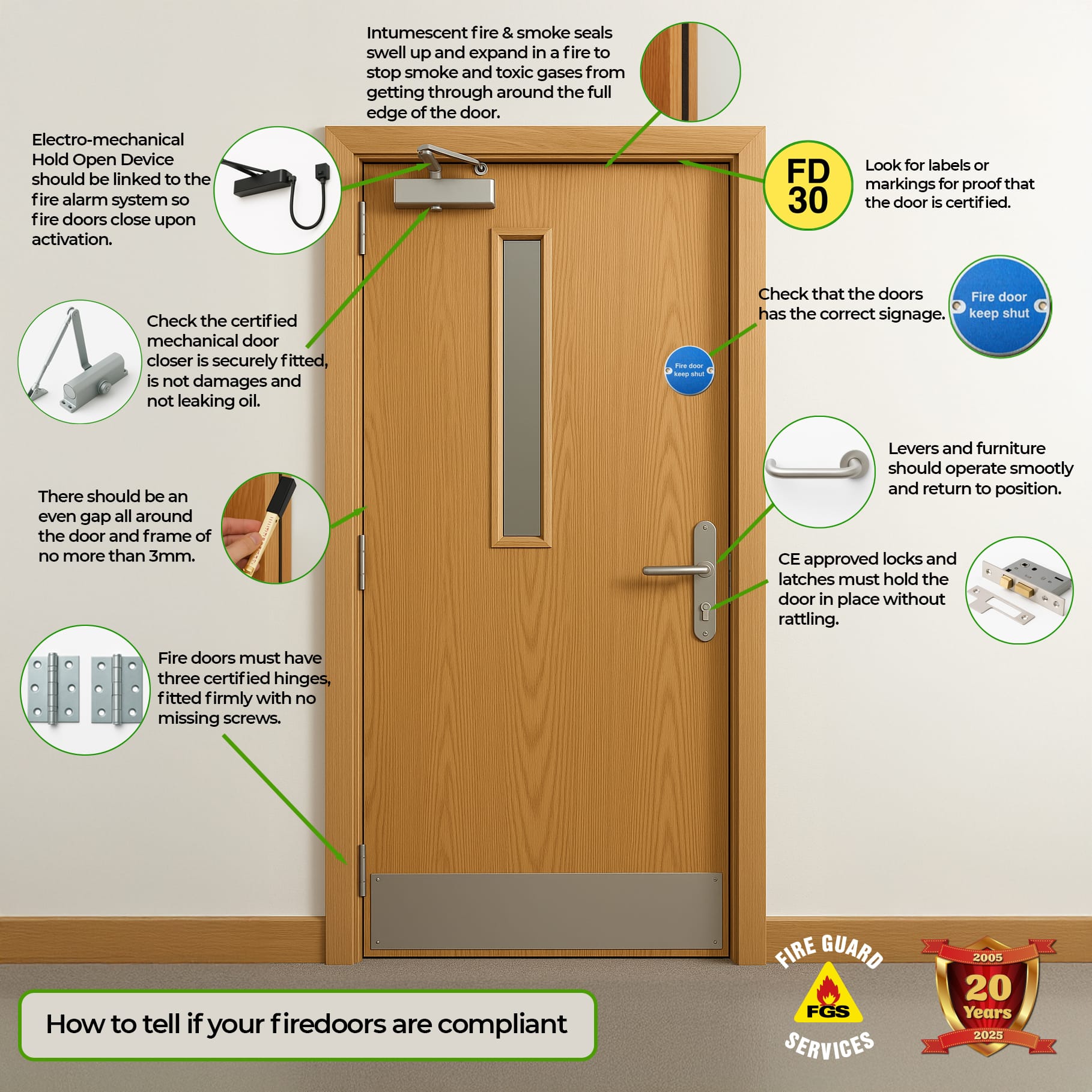Fire Door Guidance to Clarify Requirements
The UK Government has issued an important update to its fire door guidance, clarifying what is expected for existing flat entrance doors under the Fire Safety (England) Regulations 2022.

Published on 8 August 2025 by the Ministry of Housing, Communities and Local Government (MHCLG), the revised guidance adds a new foreword and amendments in three sections.
The changes address misunderstandings that had placed unnecessary burdens on leaseholders, such as advice to replace older flat entrance doors simply because they weren’t built or certified to today’s standards. This clarification is welcomed by building managers, landlords, and fire safety professionals, as it refocuses efforts on practical fire safety rather than costly compliance measures that were never intended by the law.
Why the Guidance Was Updated
According to the new foreword, some responsible persons and advisors misinterpreted the scope of the regulations. They believed every existing flat entrance fire door must meet current fire door standards for new buildings, leading to recommendations that leaseholders replace their doors. The Government was concerned by this “misunderstanding of the scope and intent” of the regulations, which was not what the law requires.
From the outset, the Fire Safety (England) Regulations 2022 were meant to improve safety in ways that are practical, cost-effective for leaseholders, and proportionate to the risk. The updated guidance therefore explicitly clarifies the purpose of these regulations: it is “not to ensure that existing flat entrance doors satisfy the current standards for flat entrance doors in new blocks of flats”, but rather to implement key recommendations from the Grenfell Tower Inquiry relating to fire doors. In other words, the focus is on making sure doors will perform adequately in a fire – especially that they self-close properly – not on mandating upgrades to the latest certification standards.
This distinction is crucial. The regulations (which came into force in January 2023) were introduced in the wake of Grenfell Tower to ensure critical safety features, like self-closing flat entrance doors, are in place and working. They were never intended to require wholesale replacement of existing fire doors that were compliant when installed. The updated foreword drives this point home “for avoidance of doubt,” making clear that if an older flat door can hold back fire and smoke for a reasonable period, it isn’t automatically deficient just because it isn’t a brand-new FD30S door.
Emphasis on Adequate Fire Performance, Not New-Build Standards
The guidance now stresses that fire safety legislation has not raised the fire resistance bar for existing doors. Changes in law after Grenfell – including the Fire Safety Act 2021 and these 2022 Regulations – did not alter the fundamental requirement that flat entrance doors must provide “adequate” fire performance to address the risk to residents.
In practical terms, if a door met the appropriate fire-resisting standards at the time the building was constructed (or when that door was manufactured and fitted), the expectation is that it still provides sufficient protection today, provided it is in good condition and properly fitted.
The updated text explicitly notes that “the absence of intumescent strips and smoke seals, and the absence of any form of certification for a fire door, does not imply that the door is unfit for purpose.” In short, an older fire door without modern seals or paperwork can still perform effectively in a fire if it’s undamaged, with no excessive gaps, and it closes securely. This clarification should reassure building owners that they don’t need to automatically rip out older doors that were once compliant, unless a fire risk assessment shows the door truly falls short on safety.
Routine Checks vs. Fire Risk Assessments

Another point underscored in the foreword is the difference between a full fire risk assessment and the routine fire door checks required by the 2022 Regulations. Under the Regulatory Reform (Fire Safety) Order 2005 (FSO) – the main fire safety law covering all common areas – building owners (the “Responsible Persons”) must have a competent fire risk assessment done. This assessment evaluates the fire resistance and condition of doors (among many other precautions) to determine if they are adequate, and it drives any needed upgrades or replacements as part of overall risk management. By contrast, Regulation 10 of the Fire Safety (England) Regulations 2022 introduces a simpler, routine inspection regime for fire doors. In high-rise residential buildings (over 11m or 4+ storeys), Responsible Persons must perform quarterly checks on all fire doors in common areas and annual checks on each flat’s entrance door that opens onto common areas. These checks are meant to be “very simple, but important” visual inspections – looking for obvious issues like damage, faulty self-closers, or dangerous gaps.
The updated guidance emphasises that these periodic door checks do not replace the deeper fire risk assessment under the FSO; rather, they complement it. The goal is to spot and fix day-to-day problems (e.g. a door that doesn’t latch or a missing hinge screw) well before they can compromise fire safety. In essence, the FSO’s risk assessment sets the standard of adequacy (based on expert judgment of risk), while the 2022 Regs’ checks help maintain that standard by keeping doors in working order. Understanding this difference helps Responsible Persons avoid overreacting – for example, thinking the law requires a door to match new-build specifications when in fact it just needs to be kept in the safe condition identified by the last risk assessment.

Intumescent Strips and Seals: New Checklist Guidance
A notable change in the Section 6.7 checklist of the guidance concerns intumescent strips and smoke seals on fire doors. Intumescent strips (which expand when heated to seal gaps) and cold smoke seals are common on modern fire doors (often combined as an “FD30S” specification), but many older doors were built to earlier standards without them. The updated guidance makes it clear that the absence of these strips/seals on an older door isn’t a violation. Specifically, it states: “The door may be acceptable, based on fire risk, even if intumescent strips and smoke seals are not present (because the door was manufactured in accordance with earlier standards). The purpose of this check is to ensure only that, if these components are present, they are undamaged.”.
In practice, when conducting routine checks, a Responsible Person should verify that if a door does have strips or seals, they haven’t been painted over or damaged and they still contact the frame properly. If a door was never fitted with strips (which might be the case in older buildings), the checker isn’t being asked to recommend retrofitting them on the spot – instead, they should ensure the door is generally sound and rely on the fire risk assessment’s judgment about that door’s overall adequacy. This clarification prevents a box-ticking mentality where any missing strip triggers a replacement; instead, it upholds a risk-based approach. It aligns with long-standing fire safety practice: small deviations from modern standards can be acceptable in existing buildings, if they don’t materially increase the risk in a real fire situation.
Implications for Responsible Persons and Leaseholders
For building owners, facilities managers, and landlords acting as Responsible Persons, the revised guidance brings welcome relief and focus. It confirms that compliance is about sensible fire risk management, not automatically upgrading everything to current standards. If a flat’s entrance door is in good repair, closes properly, and was appropriate for fire safety when installed, it can usually continue in service safely.
The priority should be on regular inspections and maintenance – e.g. oiling or fixing self-closing devices, repairing minor damage, and replacing doors only if they are found inadequate by a professional assessment. This approach is expected to ease the financial pressure on leaseholders. Many flat owners had been alarmed by advice that they must pay for new certified fire doors even when their existing doors seemed fine.
Fire safety experts have applauded the government’s clarification: industry bodies had observed a growing myth that every non-certified door must be replaced, which was “resulting in unnecessary expenditure” without a corresponding safety benefit. The Fire Industry Association (FIA), for example, recently emphasized that fire doors which don’t meet today’s standards don’t automatically need replacing, since the true legal test is whether the door is adequate in the context of a proper fire risk assessment. By echoing this expert view, the updated guidance reaffirms that a risk-based, common-sense approach is the correct one.
In summary, the August 2025 update to the fire door guidance realigns practice with intent. It helps Responsible Persons concentrate on what really matters – ensuring fire doors do their job of protecting escape routes – rather than chasing paper compliance with the latest standard. This clarification should reduce confusion and conflict between landlords and residents, as it clearly delineates reasonable fire safety measures versus overzealous demands. The Fire Safety (England) Regulations 2022 were designed to make flats safer in a practical and proportionate way, and the Government’s new guidance underscores this by dispelling the myths. Fire doors in existing buildings should be checked and kept in good order, but need not be brand-new. Ultimately, what’s required is that the door “remain adequate to address the risk” of fire – a benchmark rooted in safety outcomes, not just standards on paper.
If you need some advice on Fire Doors, or if you think you may need a Fire Risk Assessment, please feel free to contact us.
For more information on Fire Door Requirements and Certification, you may find this article useful.
